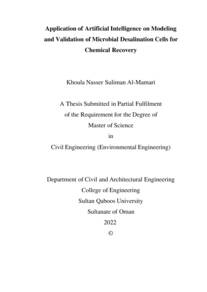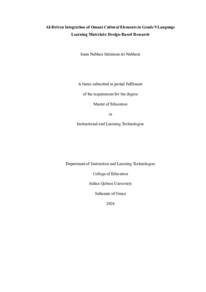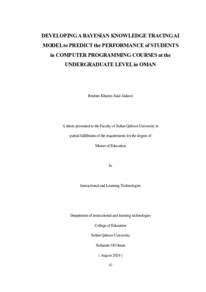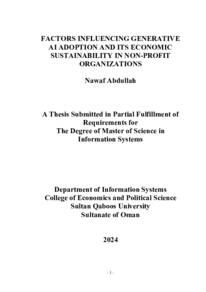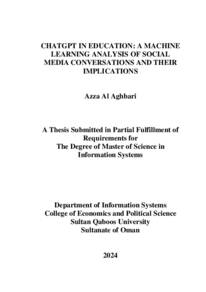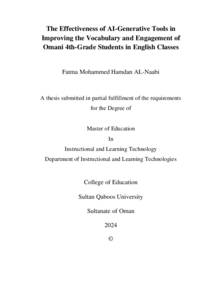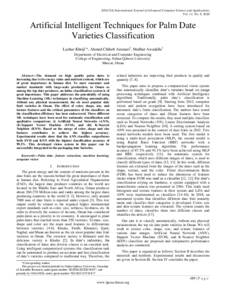Document
Application of artificial intelligence on modeling and validation of microbial desalination cells for chemical recovery.
Other titles
تطبيق الذكاء الاصطناعي في النمذجة والتحقق من صحة خلايا تحلية المياه الميكروبية لاستعادة المواد الكيميائية
Publisher
Sultan Qaboos University.
Gregorian
2022
Language
English
Subject
English abstract
The Microbial desalination cell (MDC) is an environmentally friendly water
purification technology that uses organic contaminants in wastewater as an energy
source to power the desalination process. The Microbial Desalination and Chemicals
Production Cell (MDCC) is a modified version of the Microbial Desalination Cell
(MDC) that desalinates salt water, generates electricity, and produces acid and base
simultaneously. However, electrolysis system technology optimization depends
heavily on laboratory experiments. Mathematical modeling has been proposed as a
viable replacement to laboratory experimentation due to their high costs and long
timeframes. Modeling MDCs using artificial intelegence is a potential way for
addressing these obstacles. On this research, the influence of different electrolyte to
salt ratios in the innovative two-chamber design of MDC was analyzed, along with
modeling desalination performance using Support Vector Regression (SVR) and
Multilayer Perceptron (MLP) for the first time and validating experimental results. In
addition, acid and base recovery was examined utilizing a seven chambers microbia;
desalnation cell and chemical production cell (7C-MDCC) with three external
resistances (1, 10, and 1000 ). Due to the dominating concentration gradient, the
findings indicated that the desalination rate of two chambers microbial desalnation cell
(TC-MDC) might fall in the rapid desalination zone over a long range of desalination
cycles (> 93%) at a high E/S ratio. In addition, the suggested SVR and MLP models
could estimate the desalination performance utilizing the voltage, pH of effluent,
electrolyte volume, and salt concentration of effluent as input variables. The SVR was
able to predict desalination performance with the highest degree of accuracy among
the two investigated models. Additionally, results showed that the pH of HCl and
NaOH while using 1 were reached almost 2.033 and 12.1 respectively.
Considering the volume of the acid and cathode production chambers (2L each),
results showed that the HCl and NaOH productions at the end of the cycle were 27.06
mg and 31.24 mg, respectively while using 1. Further results of 10 resistance
II
showed that the production concentration was 2.92 mg of HCl and 1.45 mg of NaOH.
Additionally, results analysis of 1K set out that in the acid-base production
concentration was 0.25 mg HCl and 10.77 mg of NaOH. More than 55% desalination
rate was reached during the operation of all three resistances. This research showed
the potential of applying renewable and sustainable energy sources to understand the
desalination behavior of the newly developed TC-MDC at different electrolyte-to-salt
ratios and to produce acids and bases using 7C-MDCC. Further, the prospect of
adopting AI to predict desalination performance. More study on optimization of
various design parameter for efficient acid base recovery needs to be done also, more
study should be done on reduction of internal resistance by optimizing the parameters.
In addition, application of AI in MDC process is still in juvenile phase, so more focus
on AI integration is needed.
Member of
Resource URL
Arabic abstract
خلية تحلية المياه الميكروبية )MDC )هي تقنية مياه صديقة للبيئة تستخدم الملوثات العضوية في مياه الصرف الصحي كمصدر للطاقة لتحفيز عملية تحلية المياه. خلية التحلية الميكروبية وإنتاج المواد الكيميائية )MDCC ) هي نسخة معدلة من خلية التحلية الميكروبية )MDC )التي تعمل على تحلية المياه المالحة وتوليد الكهرباء وإنتاج الحمض والقاعدة في آن واحد. ومع ذلك، يعتمد تحسين تقنية نظام التحليل الكهربائي بشكل كبير على التجارب العملية. تم اقتراح النمذجة الرياضية كبديل قابل للتطبيق للتجارب العملية نظرا لتكاليفها العالية والفترة الزمنية الطويلة. تعد نمذجة MDCs باستخدام تقنيات الذكاء الاصطناعي طريقة محتملة لمعالجة هذه العقبات. في النمذجة والتنبؤ بأداء MDCs، تكتسب أساليب الذكاء الاصطناعي القائمة على الشبكة العصبية الاصطناعية شعبية كبيرة. في هذا البحث، تم تحليل تأثير نسب المنحل بالكهرباء إلى نسب الملح المختلفة في التصميم المبتكر المكون من غرفتين لـلخلية الميكروبية إلى جانب نمذجة أداء تحلية المياه باستخدام دعم الانحدار المتجه )SVR )ومستقبلات متعدد الطبقات (MLP (ألول مرة والتحقق من صحة النتائج التجريبية. بالاضافة إلى ذلك، تم فحص استرداد الحمض والقاعدة باستخدام تصميم خلية تحلية ميكروبية جديدة )MDCC-C7 )مع ثلاث مقاومات خارجية مختلفة .(1, 10, and 1000 ) نظرا لتدرج التركيز السائد، أشارت النتائج إلى أن معدل تحلية المياه من MDC-C2 قد ينخفض في منطقة التحلية السريعة على مدى طويل من دورات التحلية )< 93 ٪( عند نسبة S / E عالية. بالاضافة إلى ذلك، يمكن لنماذج SVR وMLP المقترحة تقدير نسبة تحلية المياه، ونسبة التركيز، ومعدل تحلية المياه باستخدام الجهد، ودرجة الحموضة للنفايات السائلة، وحجم المنحل بالكهرباء، وتركيز الملح في النفايات السائلة كمتغيرات مدخالت. كان SVR قادًرا على التنبؤ بأداء تحلية المياه بأعلى درجة من الدقة بين النموذجين اللذين تم فحصهما. بسبب عدم كفاية البيانات، تم تجهيز نموذج MLP. بالاضافة إلى ذلك، أظهرت النتائج أن الاس الهيدروجيني لـ HCl وNaOH بلغ حوالي 2.033 و12.1 على التوالي. بالنظر إلى حجم غرف إنتاج الحمض والكاثود )2 لتر لكل منهما( ، أظهرت النتائج أن إنتاج HCl و NaOH في نهاية الدورة كان 27.06 مجم و 31.24 مجم على التوالي أثناء استخدام 1. أظهرت نتائج أخرى لمقاومة 10 أوم أن تركيز الانتاج كان 2.92 مجم من حمض الهيدروكلوريك و 1.45 مجم من هيدروكسيد الصوديوم. بالاضافة إلى ذلك ، أوضح تحليل نتائج 1 K أن تركيز إنتاج القاعدة الحمضية كان 0.25 مجم حمض الهيدروكلوريك و 10.77 مجم من هيدروكسيد الصوديوم. تم الوصول إلى أكثر من ٪55 من معدل تحلية المياه أثناء تشغيل جميع المقاومات الثلاثة.
Category
Theses and Dissertations

